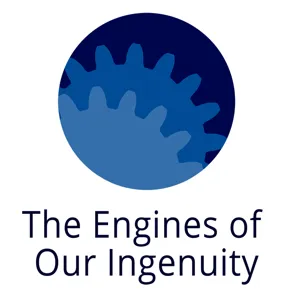Podcast Summary
Exploring X-rays and Special Discounts: The Capital One Venture X Card earns 2X miles on all purchases and comes with travel perks, while CVS offers a 20% discount on Easter orders with the code 'spring20'.
The Capital One Venture X Card offers cardholders unlimited 2X miles on every purchase, along with premium travel benefits such as airport lounge access and a $300 annual travel credit. Meanwhile, CVS is offering a 20% discount on Easter pickup orders using the promo code "spring20." In the world of Stuff You Should Know, the hosts discussed the science behind X-rays in a 2014 episode, showcasing their ability to explain complex topics in an engaging way. During a conversation about biopics, they reminisced about the Brittany Murphy movie, with some confusion about who played her and whether it was a good representation of her life.
Discovery of X-rays by Wilhelm Rüntgen: Wilhelm Rüntgen discovered X-rays in 1895 through an accidental observation of bone structures on a fluorescent screen, revolutionizing diagnosis with non-invasive procedures.
X-rays, a common diagnostic tool, were discovered accidentally by German physicist Wilhelm Rüntgen in 1895. He was experimenting with cathode rays when he noticed that a fluorescent screen was glowing, even though it shouldn't have been. Upon further investigation, he discovered that bones were also visible on the screen. The discovery was a significant breakthrough, as it allowed for the non-invasive diagnosis of injuries and diseases. Prior to this, injuries and illnesses often required invasive procedures for diagnosis. Both the hosts of the podcast shared their personal experiences with X-rays, which had mostly been related to dental procedures. They also discussed the dry and straightforward documentation of the discovery they had found online.
Roentgen's Discovery of X-rays and Its Impact on Medicine: Roentgen discovered X-rays in 1895, named them as a placeholder, and revolutionized medicine with their diagnostic capabilities, leading to their widespread use today.
Wilhelm Conrad Roentgen, the first person to discover x-rays in 1895, named them as a placeholder and didn't patent or profit from his discovery. His wife, who had hand cancer, was the first person to be X-rayed. X-rays are a type of electromagnetic radiation, falling between gamma rays and ultraviolet rays on the electromagnetic spectrum. They are carried on photons, which are particles of light. When an electron drops to a lower orbital in an atom, it releases a photon, and the energy of the photon depends on how far the electron drops. X-rays were first practically used during the first World War to detect bullets and shrapnel. Roentgen's discovery revolutionized medicine and continues to be an essential diagnostic tool today. Despite his modest beginnings, Roentgen's discovery had a profound impact on science and medicine.
Photons transfer energy to atoms based on orbital energy differences: Photons interact with atoms and transfer energy only when their energy matches the specific orbital energy difference, with higher energy photons more likely to interact.
Photons, as energy carriers in the electromagnetic spectrum, can transfer energy to atoms only if their energy matches the exact energy differential between specific orbitals. The greater the energy of the photon, the more likely it is to interact with an atom and transfer its energy. If the energy is too low, the photon won't be able to move the electron to a higher orbital. Conversely, if the energy is too high, the photon may pass through the atom without interaction. This principle explains why different types of electromagnetic radiation, such as radio waves and x-rays, have varying abilities to interact with matter. Radio waves, with low energy, cannot transfer electrons between orbitals and simply pass through matter. X-rays, with high energy, can penetrate matter and interact with atoms, making them useful for medical imaging.
X-rays reveal differences in atomic density: X-rays distinguish between bones and soft tissue due to their varying atomic densities, with high-density elements absorbing more radiation and appearing darker on the image.
The difference in atomic density between various elements, such as bones and soft tissue, is what allows x-rays to produce clear images. High-density elements like calcium in bones absorb more x-ray energy, resulting in a darker image on the x-ray plate. Conversely, lower-density elements like soft tissue allow more x-ray energy to pass through, resulting in a lighter image. This principle is based on the fact that different atoms have varying atomic weights and densities, and their ability to absorb energy is a key factor in x-ray imaging. The use of lead in x-ray machines is another important factor, as its high atomic number and density make it an effective absorber of x-rays, protecting patients from unnecessary radiation exposure.
How X-ray machines generate x-rays: X-ray machines use vacuum tubes to generate x-rays through a process involving heated filaments, electrical charges, and the interaction between photons and electrons.
X-ray machines use vacuum tubes to generate x-rays through a process involving heated filaments, electrical charges, and the interaction between photons and electrons. These machines, which were first discovered accidentally, are still in use today due to their ability to produce x-rays efficiently. The x-rays generated are a result of humans and lead aprons, as well as the machine itself. The process involves electrons being emitted from a cathode and accelerated towards a tungsten anode, where they collide and create x-rays. This process can also lead to a chain reaction, with more electrons being knocked off and more x-rays being generated. Despite the advanced nature of the technology, the vacuum tubes used are still made by hand and are superior to solid state alternatives for producing rich sounds, such as in guitar amps. The generation of x-rays also produces a significant amount of heat, which is managed through the rotation of the anode and the use of an oil bath to absorb the excess heat.
Medical Imaging Technologies and Music Awards: Medical imaging uses radiation and contrast media to create detailed images, while music awards honor artists and trends
Medical imaging technologies like CT scans, mammography, and fluoroscopy use various techniques to produce detailed images of the body's internal structures. X-rays, a type of radiation, are often used, but they can pass through soft tissues, making it necessary to use contrast media for better visualization. Fluoroscopy, in particular, provides moving images, allowing doctors to observe the functioning of organs like the heart. Standard radiography, on the other hand, produces a single still image of a body part, such as the skull or lungs. Despite the use of radiation, these procedures are essential for diagnosing and treating various health conditions. Additionally, music awards shows like the iHeartRadio Music Awards celebrate the biggest artists and trends in the music industry.
Exploring the World of Podcasts: Education, Entertainment, and Personal Experiences: Podcasts provide diverse content and perspectives, offering both education and entertainment, with topics ranging from true crime to dating advice. Be aware of potential dangers, such as excessive x-ray use leading to health risks.
Podcasts cover a wide range of topics, from true crime to dating advice, and can provide both entertainment and education. For instance, the podcast "West Study" discusses the hardships and dangers of the Oregon Trail, while "Day in my Abuelita's" podcast focuses on matchmaking and dating. Additionally, the discussion highlighted the potential dangers of x-rays, which were used excessively in the past and can lead to radiation sickness, mutations, and even cancer. It's important to be aware of the risks and use x-rays in moderation. Rachel from "West Study" shared her personal experiences, including encounters with danger and deceit, while "Two Jersey J's" offers advice for women in their 40s and 50s. The Eds' podcast reveals a different side of the real housewives' husbands, and "Day in my Abuelita's" podcast offers a fun and unconventional dating experience. Overall, podcasts offer a diverse range of content and perspectives, making them a valuable source of information and entertainment.
Medical procedures contribute to significant radiation exposure: Avoid unnecessary medical procedures and consider alternatives to minimize radiation exposure, as one CT scan can equal 2-3 years of natural radiation.
While we are exposed to radiation every day, medical procedures such as CT scans and x-rays contribute significantly to our annual radiation exposure. For instance, a full CT scan can expose us to up to 10 millisieverts, which is equivalent to two to three years' worth of natural radiation. It's crucial to use these diagnostic tools judiciously and consider alternatives when possible. Other sources of radiation include flying, baggage scanners, and industrial applications. While x-rays have numerous benefits, it's essential to be aware of the potential risks and minimize unnecessary exposure.
X-rays: Revolutionary Diagnostic Tool with Risks: X-rays revolutionized healthcare, but excessive exposure can have negative health effects. Alternative therapies like Neurotrophic Stimulation Therapy (NTST) promote neuroplasticity and can treat trauma and PTSD.
While there are potential risks associated with x-rays, they are still considered safer than the alternatives they replaced, such as exploratory surgery. X-rays have revolutionized healthcare by providing a non-invasive way to diagnose injuries and diseases. However, it's important to note that excessive exposure to x-rays can have negative health effects. Another interesting alternative therapy mentioned in the discussion is Neurotrophic Stimulation Therapy (NTST), which uses ear acupuncture and electro acupuncture to promote neuroplasticity in the brain. This therapy can help the brain re-regulate certain functionality, allowing it to heal itself. It's been effective in treating trauma and PTSD patients, and can even make cognitive behavioral therapies more effective. If you're interested in learning more about x-rays or alternative therapies, check out the article on howstuffworks.com or consider supporting Poppy's cause by visiting lastdoor.org/NTST. Remember, every little bit helps in making a difference. In conclusion, while there are risks associated with x-rays, they have revolutionized healthcare and continue to be a crucial diagnostic tool. Alternative therapies like NTST offer promising solutions for treating conditions like trauma and PTSD, and it's important to stay informed about the latest advancements in healthcare.
New podcasts and music awards on iHeart Radio: Discover exclusive interviews and performances from top artists on The Bright Side podcast, and tune into the iHeartRadio Music Awards for the biggest summer hits on Fox. Explore the world of truck stop brothels with Dr. Lindsey Byron on Hooker Game, Criminals and Libertines in the South.
IHeart Radio is bringing fans exciting new content in the form of podcasts and music awards. The Bright Side podcast on iHeart Radio is a must-listen for music lovers, featuring exclusive interviews and performances from renowned artists like Beyonce, Justin Timberlake, Green Day, TLC, Jelly Roll, Lainey Wilson, and hosted by Ludegris. The 2024 iHeartRadio Music Awards will also be broadcasted on Fox, showcasing the biggest new songs of the summer. On a different note, Hooker Game, Criminals and Libertines in the South is another intriguing podcast available on iHeartRadio, Apple Podcast, or wherever you get your podcasts. Hosted by Dr. Lindsey Byron, this podcast takes listeners on a journey through the world of truck stop brothels and the complex web of ex-cons and power dynamics involved. Tune in to these captivating podcasts for unique perspectives and engaging stories.






